Most of us love taking pictures, and it’s no wonder, since the beauty of the world around us is just asking to be photographed. But sometimes, no matter how exceptional the object, the photograph seems to be lacking the initial charm that made us want to capture it. One of the main reasons for this is inadequate composition.
Composition is an essential element which makes or breaks a photograph. The way you choose to arrange what’s visible in the picture is often more important than the very subject you’re photographing. Also, good composition has the power to convey messages and evoke emotions you wouldn’t even think of.
There’s a myriad of rules and advices on photography and composition, but that doesn’t mean you have to know all of them to take a great picture. You also don’t have to be a professional photographer to do it. However, knowing the basic rules that make up composition is essential. That’s why we decided to present you with the cream of the cream when it comes to composition so that your next photos will rock.
Now before we move any further, stop reading this article and take a look out of a nearest window. What can you see? What is the prevailing element that’s always there when you look?
Lines.
- Leading lines
Buildings, roads, paths, fences, trees, their branches, electric lines sizzling above the street – are all lines. And we as people have a tendency to follow lines.
Including lines in your photographs is an excellent way to guide viewer’s attention towards your subject and make the picture more interesting and intriguing.
Consider this photo:
Image Credit: Walk The Walk by Thomas Leth-Olsen
As you can see the subject, the walking man, is one of the smallest constituents which make the picture, yet thanks to the lines on the pavement our attention is instantly drawn to him. The picture itself is a play of lines. When you look closer, you’ll see that almost the whole photo is made up of them, and the result is compelling.
With appropriate usage of lines in your composition, you can achieve the following:
- direct the viewer’s attention towards the subject
- create sense of depth
- add tension to the photo
- take the viewer on a journey through the photo
- Diagonals
While horizontal and vertical lines make pictures seem static and balanced, diagonals will add movement to your pictures. They’re especially important if you want your photos to be more dynamic. But they’re also a great way to add a sense of restlessness and uneasiness to the picture – ideal for dramatic images.
Let’s consider this photograph:
Image Credit: Lines by Hernán Piñera
The arrangement of diagonals here gives us the feeling of vertigo, and the lines leading to the top of the bridge make us feel claustrophobic and small. The effect: powerful picture.
Pro-Tip:
If there are no diagonals near the subject of your interest, you can always slightly tilt your camera while taking a picture. This works especially well with tall buildings, underscoring their height and imposing nature.
- The Less The Better
Unless there’s a justified reason for you to photograph all of what makes a particular scene, don’t do it. Putting a lot of elements into a picture will significantly weaken its message, because the viewer won’t be able to pick out the subject of the photograph, and the picture itself will be confusing.
This leads us to another point, balancing elements.
Proper distribution of subjects in a picture can help you emphasize the overall message you want to convey. For example, if you see a big signpost or something else considerable in size, you might be tempted to photograph only that object, leaving the rest of the frame empty. While it’s not entirely wrong, giving big objects a counterpart is a good way to underline their dimensions and emotional load. By doing that you’re not only giving your viewers a proper perspective, but also you’re filling the frame.
Here you can find more tips on balance in photography.
- Rule of Thirds
The Rule of Thirds is a very useful composition technique that makes pictures more interesting and dynamic. It begins with you mentally splitting the frame into 3 x 3 even parts, like this:
Image Credit: MyPaint Bordered Template Pack by Songwind
The intersecting lines indicate where the focal points of your subject should be. Let it be your subject’s eye, the top of a mountain, a dog’s head, etc.
Compare the two pictures:
The main subject placed right in the middle (Rule of Thirds omitted).
Image Credit: Sunflower field in the Ardeche region by Peter Heeling
And now with the Rule of Thirds applied:
Image Credit: Rule of Thirds by Alan Levine
The second picture is more balanced and visually pleasing. There’s much more going on with the addition of smaller sunflowers in the lower left. For example, we can imagine how the plant is growing, and we see different stages of its growth.
- Framing
Using elements from your surroundings as a frame to capture your subject in is an excellent way to emphasize the message of the photograph and draw the viewer’s attention toward the subject.
You can use many obvious elements from your surrounding as frames: windows, doors, walls, but there are plenty of other less common objects that you can use for framing. Don’t be afraid to experiment!
Here’s a great example using naturally occurring elements (branches) as frames:
Image Credit: The Silhouette Cat by HiggySTFC
By isolating your subject this way you can evoke a wide array of emotions and associations. Beginning with feelings of loneliness and detachment, and ending with a sense of security like in the picture with the cat.
While all of the five rules of composition mentioned in the article will make your pictures outstanding, don’t be afraid to experiment. Photography is an art. It’s a game of creativity which, as all of us know, wouldn’t be possible bound by the rules.
Have any pictures you’re particularly proud of? Print them out on a vintage print from PhotoLove and hang on a wall in your house or at work. Filling your surroundings with beautiful images is the best way to brighten up any day no matter how gray or dull it is.






